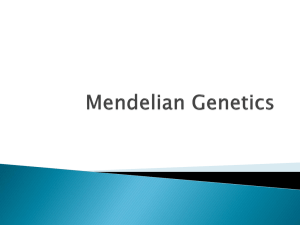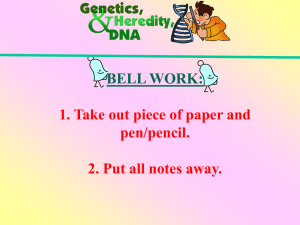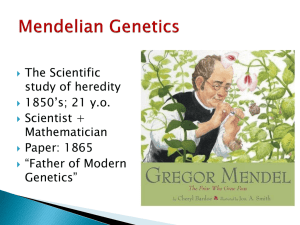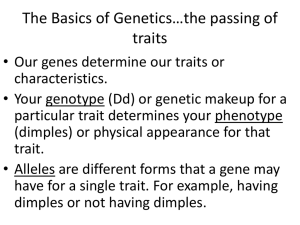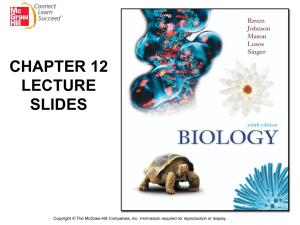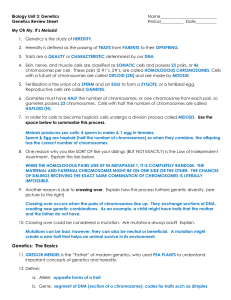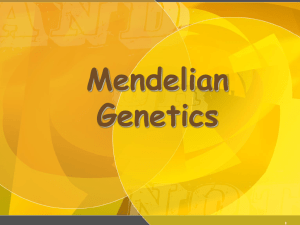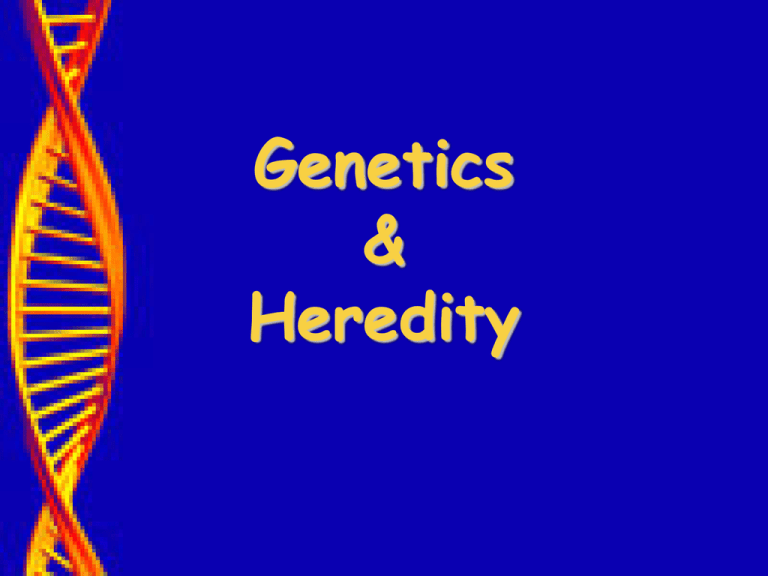
Genetics
&
Heredity
Who was Gregor Mendel?
• Austrian monk who
studied mathematics
and science
• Between 1856-1863
Mendel made careful
use of scientific
methods, which
resulted in the first
recorded study of how
traits pass from one
generation to the next.
What is GENETICS?
The study of
how traits
are inherited
through the
interactions
of genes.
What is a GENE?
• The material
that controls
which traits are
expressed in an
organism
• Genes come in
pairs and
offspring inherit
one copy of each
gene from each
parent
Define HEREDITY
The passing of traits from parent to
offspring
Define ALLELE
The different forms of a trait that a gene
may have. One form of a gene
Define TRAIT
Ways of looking, thinking, or being.
Traits that are genetic are passed down
through the genes from parents to
offspring
Describe RECESSIVE
• A trait that is covered over,
or dominated, by another
form of that trait and seems
to disappear
• Hidden when the other copy
of the gene contains the
dominant allele.
• A recessive allele shows up
only when there is no
dominant allele present
• Shown with a lower-case
letter
Describe DOMINANT
• A trait that covers over,
or dominates, another
form of that trait
• Trait that always shows
up, even when only one of
the two alleles is in the
dominant form
• Shown by a capital letter
What is HOMOZYGOUS?
• Both alleles [forms of the gene]
are the same
• When offspring inherit two
dominant genes, (one dominant gene
from each parent) they are said to
be homozygous dominant
• When offspring inherit two
recessive genes, (one recessive
gene from each parent) they are
said to be homozygous recessive
What is HETEROZYGOUS?
• When alleles occur in different
forms
• When offspring inherit one
dominant gene and one recessive
gene, they are said to be
heterozygous
• Since the dominant gene will be
expressed, they are said to be
heterozygous dominant
Define GENOTYPE
An organism's genetic makeup
Define PHENOTYPE
Outward physical appearance
and behavior of an organism
What is a PUNNETT SQUARE?
• A tool to predict the
probability of certain
traits in offspring that
shows the different ways
alleles can combine.
• Letters stand for
dominant and recessive
alleles
• An uppercase letter
stands for a dominant
allele
• Lowercase letters stand
for recessive alleles
Monohybrid Cross
A breeding experiment that tracks the
inheritance of one traits.
• Trait: Seed Shape
• Alleles: R – Round r – Wrinkled
• Cross: Round seeds x Wrinkled seeds
•
RR
x
rr
Genotype: Rr
r
r
R
Rr
Rr
R
Rr
Rr
Phenotype: Round
Genotypic
Ratio: All alike
Phenotypic
Ratio: All alike
13
Dihybrid Cross
A breeding experiment that tracks the
inheritance of two traits.
RY
RY RRYY
Ry
RRYy
rY
RrYY
ry
RrYy
Round/Yellow:
9
Round/green:
3
Ry RRYy
RRyy
RrYy
Rryy
rY RrYY
RrYy
rrYY
rrYy wrinkled/green:
ry
RrYy
Rryy
rrYy
rryy
wrinkled/Yellow: 3
1
9:3:3:1 phenotypic
ratio
14
Generation “Gap”
• Parental P1 Generation =
the parental generation in
a breeding experiment.
• F1 generation = the firstgeneration offspring in a
breeding experiment. (1st
filial generation)
– From breeding
individuals from the
P1 generation
• F2 generation = the
second-generation
offspring in a breeding
experiment.
(2nd filial generation)
– From breeding
individuals from the F1
generation
15
Describe Co-Dominance and
Incomplete Dominance
Incomplete Dominance
when both alleles are
present, neither is
dominant, and the flower
color is pink due to the
blending of colors.
Co-Dominance is when two
alleles are expressed
and one does not mask
the other.
List the 3 Principles of
Heredity
• Traits are controlled by alleles on
chromosomes
• An allele’s effect is dominant or
recessive
• When a pair of chromosomes
separate during meiosis the
different alleles for a trait move
into separate sex cells
Law of Segregation
• During the formation
of gametes (eggs or
sperm), the two
alleles responsible for
a trait separate from
each other.
• Alleles for a trait are
then "recombined" at
fertilization,
producing the
genotype for the
traits of the
offspring.
18
Law of Independent
Assortment
• Alleles for different
traits are distributed
to sex cells (&
offspring)
independently of one
another.
• This law can be
illustrated using
dihybrid crosses.
19
What is meant by
MULTIPLE ALLELES?
• A trait that is controlled by more than
two alleles is said to be controlled by
multiple alleles
• Traits controlled by multiple alleles
produce more than three phenotypes of
that trait
For Example:
The alleles for blood types in humans are
called A, B, and O
The O allele is recessive to both the A and B
alleles
What is POLYGENIC
INHERITANCE?
• Occurs when a
group of gene
pairs acts
together to
produce a trait
• The effects of
many alleles
produces a wide
variety of
phenotypes
What is a Karyotype
• The
characterization
of the
chromosomal
complement of
an individual or a
species, including
number, form,
and size of the
chromosomes.
What is a pedigree chart?
• Pedigree charts show a record of
the family of an individual
• They can be used to study the
transmission of a hereditary
condition
• They are particularly useful when
there are large families and a good
family record over several
generations.
Symbols used in pedigree
charts
•
•
•
•
•
A marriage with five children, two
daughters and three sons. The
eldest son is affected by the
condition.
Normal male
Affected male
Normal female
Affected female
Marriage
Eldest child Youngest child
Organizing the pedigree chart
– Generations are identified by Roman
numerals
I
II
III
IV
DNA Fingerprinting
•
DNA Fingerprinting is a procedure whereby the genetic information,
called DNA, in a person's cells is analyzed and identified. The word
fingerprinting is used because, just like a fingerprint, no two person's
genetic code is exactly the same. It can be used to:
– Determine Family Relationship - DNA can help find out who a person's
parents or siblings are. Prenatal paternity tests are available to mothers who
need to identify the father of their unborn babies.
– Detect Inherited Diseases - Your genetic code can be tested to determine
your likelihood of getting certain diseases.
– Prove Guilt or Innocence - DNA left at the scene of a crime can be
matched with a sample from a suspect.
– Identify a Dead Body - The DNA from an unidentified body can be
matched with a person in a government DNA database.
Sample Of A DNA Fingerprint



